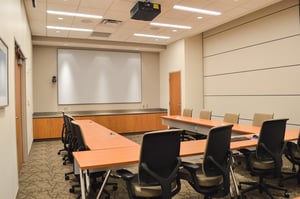 Have you ever been to a movie theatre and sat too close? Have you ever been to a drive-in and parked too far way? Have you ever been to a conference and been seated too far to one side or the other? All of these situations can be frustrating and result in a less than optimum experience, no matter the platform. This scenario can be even more of a concern when it comes to communicating in your organization. If you are making a presentation from a projector, creating an opportunity for everyone, no matter where in the room, to see, hear, and understand the information being displayed is critical. The right projection screen and appropriate size can mitigate the problems mentioned above.
Have you ever been to a movie theatre and sat too close? Have you ever been to a drive-in and parked too far way? Have you ever been to a conference and been seated too far to one side or the other? All of these situations can be frustrating and result in a less than optimum experience, no matter the platform. This scenario can be even more of a concern when it comes to communicating in your organization. If you are making a presentation from a projector, creating an opportunity for everyone, no matter where in the room, to see, hear, and understand the information being displayed is critical. The right projection screen and appropriate size can mitigate the problems mentioned above.
What should determine screen size?
One of the most significant advantages of a projector system is its size and scalability. Projectors and screens are also an affordable alternative to television displays. While the cost between upgrading from a 50” display to a 70” display can be significant, growing from a 106” screen to 120” or bigger can be quite budget-friendly. However, it is essential to understand what size screen is appropriate for your space.
Begin with how far away your audience should sit from the screen. For a 1080p HD projector, your viewing distance should be 1 to 1 ½ times of the screen’s diagonal measurement. For a 4K projector, you can sit as close as one times the diagonal measurement. The closer you sit, the more detail you’ll be able to see.
Working backward and understanding where your viewers need to sit, based on your available space, you can determine the appropriate size for your screen.
Why is a screen better than a wall?
The screen plays a significant role in how the projector delivers. Even a pristinely painted wall can’t provide the same results as a screen. Screens enhance the overall performance of your projector by creating a smooth, crisp image. Not only does a screen’s vinyl material maintain an even display, but they also feature a special coating that limits the way that your projector’s light is reflected.
What material is best for your projection screen?
There are three key considerations for selecting screen material. The material of your screen needs to correspond with your projector and the room.
- Gain – Gain affects the brightness of the image being projected. A higher grain generates a brighter image.
- Color – Screens don’t come in a wide variety of colors, typically white or a varying shade of gray. A gray option will boost contrast and provide deeper blacks.
- Texture – Screens come with a wide variety of “grit,” or fine texture that can deliver all of the detail of 4k projection.
What is the difference between retractable screens and fixed-frame screens?
Screens come in two different varieties; fixed-frame and retractable. The type that you choose will depend on your space and how you plan to use it. A fixed-frame screen needs a large section of empty wall space. Retractable screens can be stored when not in use. So if your area operates in multiple ways, having the option to move or hide your screen can be convenient. Retractable screens can be simple and manually retractable, or automatic with an electric motor.
One of the most important things you can do when updating, upgrading, or installing a projection system is to entrust the process to an experienced AV integration firm. The experts at Link Integration Group help businesses and organizations with their technology needs.

